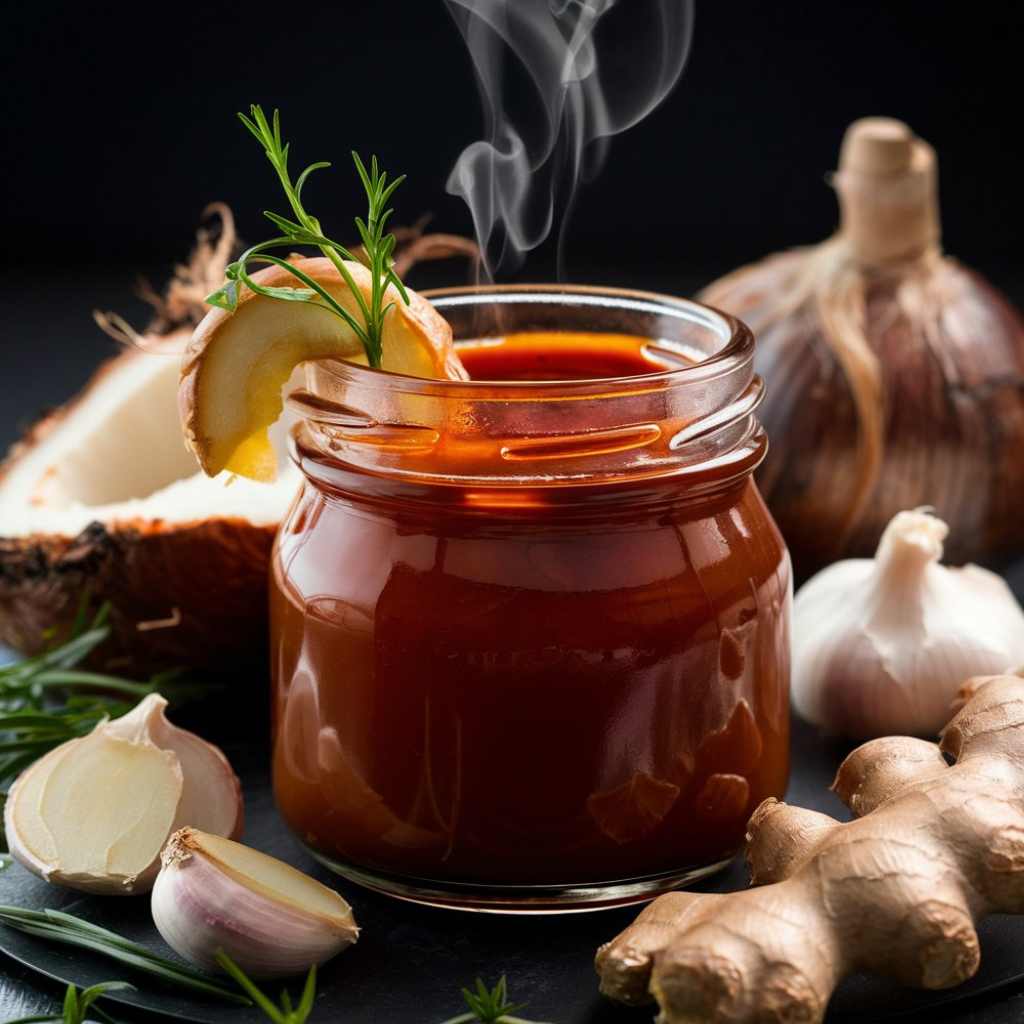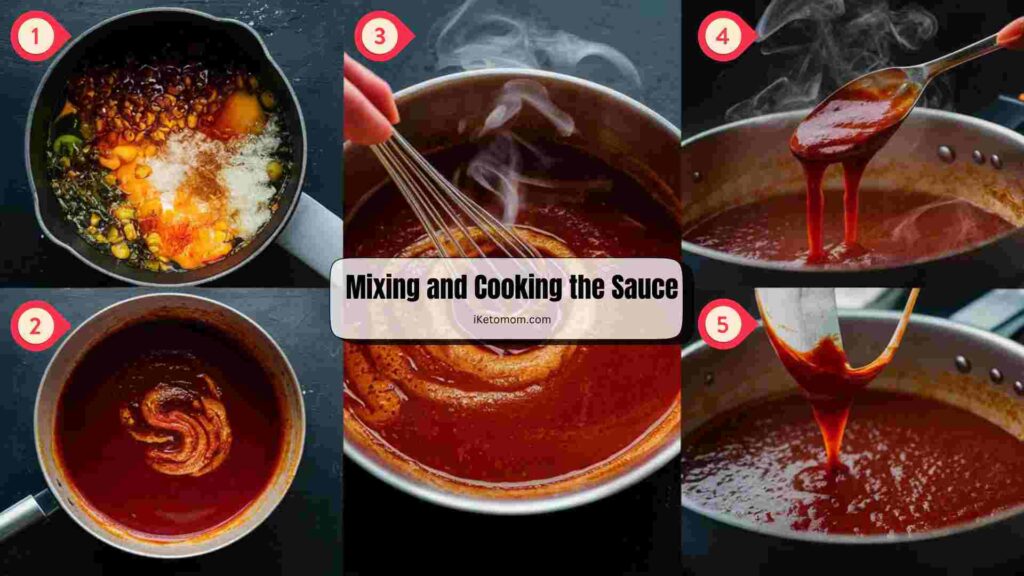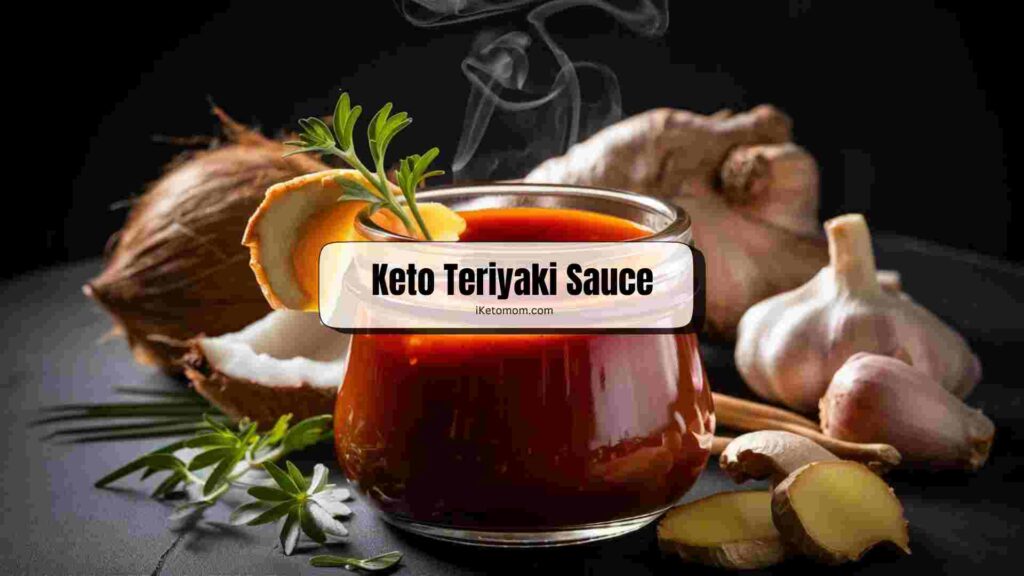Keto Teriyaki Sauce is a flavorful and low-carbohydrate alternative to traditional teriyaki sauces, tailored specifically for individuals following the ketogenic diet. This sauce maintains the signature sweet and savory profile of teriyaki sauce while eliminating or reducing the sugar content found in conventional recipes. It combines keto-friendly ingredients like coconut aminos (or tamari sauce), low-glycemic sweeteners such as erythritol or monk fruit sweetener, and aromatic spices like garlic and ginger. The result is a delicious sauce that complements a wide range of dishes while adhering to the principles of a low-carb, high-fat ketogenic lifestyle.
The ketogenic diet, often referred to as keto, is a dietary approach focused on consuming high amounts of healthy fats, moderate protein, and very low carbohydrates. The goal of the keto diet is to shift the body’s metabolism into a state of ketosis, where it primarily burns fats for energy instead of carbohydrates. This metabolic state is achieved by drastically reducing carbohydrate intake, typically to around 20-50 grams per day, and increasing fat consumption to provide the body with a steady source of energy.
By minimizing carb intake, the keto diet forces the body to rely on ketones, produced from fats, as its primary fuel source. This shift not only promotes weight loss by encouraging the body to burn stored fat but also offers other potential health benefits such as improved blood sugar control, increased mental clarity, and enhanced energy levels.
Keto Teriyaki Sauce Recipe
Ingredients
Soy Sauce Alternatives:
- Coconut Aminos: Coconut aminos are derived from coconut sap and are a popular soy sauce alternative in keto and paleo diets. They have a similar umami-rich flavor to soy sauce but are lower in sodium and free from soy, gluten, and wheat. Coconut aminos add depth and savory notes to the teriyaki sauce without compromising its keto-friendly status.
- Tamari Sauce: Tamari sauce is a gluten-free version of soy sauce made from fermented soybeans. It has a slightly richer and less salty taste compared to traditional soy sauce. Tamari sauce is suitable for those with gluten sensitivities or following a gluten-free keto diet.
Sweeteners:
- Erythritol: Erythritol is a sugar alcohol that provides sweetness without impacting blood sugar levels or insulin response, making it ideal for keto recipes. It has zero net carbs and is commonly used as a sugar substitute in low-carb and sugar-free cooking. Erythritol adds a subtle sweetness to the teriyaki sauce without contributing to the carb count.
- Monk Fruit Sweetener: Monk fruit sweetener is derived from the extract of monk fruit and is another popular keto-friendly sweetener. It is intensely sweet, so a small amount goes a long way. Monk fruit sweetener contains zero calories and zero carbohydrates, making it an excellent choice for maintaining ketosis while satisfying cravings for sweetness.
Other Key Ingredients:
- Ginger: Fresh ginger adds a zesty and aromatic flavor to the teriyaki sauce. It is commonly used in Asian cuisine for its warming and slightly spicy notes. Grating or mincing the ginger releases its essential oils and enhances the overall taste of the sauce.
- Garlic: Garlic lends its distinctive pungent flavor to the teriyaki sauce, balancing the sweetness and adding depth of flavor. Minced garlic is typically used in the sauce for easy incorporation and even distribution of flavor throughout the dish.
- Vinegar: Vinegar, such as apple cider vinegar or rice vinegar, adds a tangy acidity to the teriyaki sauce. It helps balance the flavors and provides a subtle tartness that complements the sweetness and umami elements. Vinegar also acts as a natural preservative, prolonging the shelf life of the sauce.
These carefully selected ingredients work together to create a delicious and keto-friendly teriyaki sauce that is full of flavor while aligning with the principles of the ketogenic diet. Adjust the quantities of ingredients based on personal taste preferences to customize the sauce to your liking.
Instructions:
Preparation of Ingredients for Keto Teriyaki Sauce:
- Gather and Measure Ingredients:
- Start by gathering all the ingredients needed for the Keto Teriyaki Sauce as listed in the recipe. Measure out 1 cup of coconut aminos (or tamari sauce), 1/4 cup water, 3 tablespoons of erythritol (or monk fruit sweetener), 2 cloves of minced garlic, 1 teaspoon of grated ginger, and 1 tablespoon of apple cider vinegar (or rice vinegar).
- Prepare Fresh Ingredients:
- If using fresh garlic and ginger, peel and mince the garlic cloves and grate the ginger using a fine grater. This step ensures that the garlic and ginger release their flavors fully into the sauce.
Mixing and Cooking the Sauce:
- Combine Ingredients in Saucepan:
- In a saucepan over medium heat, add the coconut aminos (or tamari sauce), water, erythritol (or monk fruit sweetener), minced garlic, grated ginger, and apple cider vinegar (or rice vinegar).
- If using, add the optional tablespoon of sesame oil to the saucepan as well.
- Stir and Bring to a Simmer:
- Use a whisk or spoon to stir the ingredients together until the sweetener is fully dissolved and the mixture is well combined.
- Once combined, bring the sauce to a gentle simmer over medium heat. Stir occasionally to prevent sticking or burning.
- Cooking Time:
- Let the sauce simmer for about 5-7 minutes. Simmering allows the flavors to meld together and the sauce to slightly thicken. Stir occasionally during this time to ensure even cooking.
Adjusting Consistency and Flavor:
- Taste and Adjust Sweetness/Saltiness:
- After cooking, taste the sauce to assess the sweetness and saltiness levels. Adjust the sweetness by adding more erythritol (or monk fruit sweetener) if desired. You can also adjust saltiness with a pinch of salt if needed.
- Adjusting Consistency:
- If the sauce is too thick for your liking, add a splash of water to thin it out. Stir well to incorporate the water into the sauce and check the consistency.
- Conversely, if the sauce is too thin, continue simmering for a few more minutes to reduce and thicken slightly. Keep in mind that the sauce will thicken further as it cools.
- Optional Flavor Enhancements:
- If you prefer a stronger flavor, you can simmer the sauce for a few extra minutes to intensify the flavors. Be cautious not to overcook, as this can lead to a concentrated and overly strong taste.
By following these detailed steps for preparation, mixing and cooking, and adjusting consistency and flavor, you’ll create a delicious and customizable Keto Teriyaki Sauce that perfectly suits your taste preferences and dietary needs. Enjoy using this sauce to elevate your keto-friendly meals!
Keto Teriyaki Sauce is a delicious and low-carb alternative to traditional teriyaki sauce, tailored specifically for those following a ketogenic diet. Traditional teriyaki sauce is often high in sugar and carbohydrates, which can hinder ketosis, the metabolic state central to the keto diet. This keto-friendly version maintains the essential sweet and savory flavors of classic teriyaki but uses ingredients like coconut aminos or tamari sauce as a base, and keto-approved sweeteners such as erythritol or monk fruit sweetener. These substitutions significantly reduce the carbohydrate content while preserving the rich umami taste that makes teriyaki sauce so popular.
In addition to being keto-compliant, Keto Teriyaki Sauce is versatile and easy to make. Fresh garlic and ginger provide aromatic depth, while a splash of apple cider vinegar adds tanginess, balancing the overall flavor profile. This sauce can be used in a variety of ways, including as a marinade for meats, a glaze for grilled dishes, or an enhancement for stir-fries and vegetable dishes. Its adaptability makes it a valuable addition to any keto kitchen, allowing those on a low-carb diet to enjoy the familiar and comforting flavors of teriyaki without compromising their nutritional goals.
Keto Teriyaki Sauce Nutrition Info
Here is an approximate nutrition table for the entire batch of Keto Teriyaki Sauce based on the provided ingredients. Note that actual values may vary depending on the specific brands and measurements used.
| Nutrient |
Amount per Batch
|
| Calories | 114 |
| Total Fat | 0g |
| Saturated Fat | 0g |
| Trans Fat | 0g |
| Cholesterol | 0mg |
| Sodium | 1800mg |
| Total Carbohydrates | 30g |
| Dietary Fiber | 0g |
| Sugars | 0g |
| Sugar Alcohols | 18g |
| Net Carbs | 12g |
| Protein | 0g |
Here’s a consolidated nutrition table for each ingredient used in the Keto Teriyaki Sauce:
| Ingredient | Calories | Total Fat | Saturated Fat | Trans Fat | Cholesterol | Sodium | Total Carbohydrates | Dietary Fiber | Sugars | Sugar Alcohols | Protein |
|---|---|---|---|---|---|---|---|---|---|---|---|
| Coconut Aminos (1 cup) | 90 | 0g | 0g | 0g | 0mg | 1800mg | 18g | 0g | 0g | 0g | 0g |
| Water (1/4 cup) | 0 | 0g | 0g | 0g | 0mg | 0mg | 0g | 0g | 0g | 0g | 0g |
| Erythritol (3 tbsp) | 12 | 0g | 0g | 0g | 0mg | 0mg | 12g | 0g | 0g | 12g | 0g |
| Garlic (2 cloves) | 8 | 0g | 0g | 0g | 0mg | 0mg | 2g | 0g | 0g | 0g | 0g |
| Ginger (1 tsp) | 1 | 0g | 0g | 0g | 0mg | 0mg | 0g | 0g | 0g | 0g | 0g |
| Apple Cider Vinegar (1 tbsp) | 3 | 0g | 0g | 0g | 0mg | 0mg | 0g | 0g | 0g | 0g | 0g |
| Optional: Sesame Oil (1 tbsp) | 120 | 14g | 2g | 0g | 0mg | 0mg | 0g | 0g | 0g | 0g | 0g |
These values are approximate and can vary based on specific brands or variations in the ingredients used. Always refer to the nutrition labels on the products you use for precise information.
Tips for Best Results
- Use Fresh Ingredients:
- Fresh garlic and ginger provide the best flavor. Mince the garlic finely and grate the ginger just before adding them to the sauce to maximize their aromatic qualities.
- Adjust Sweetness to Taste:
- The sweetness level can vary based on personal preference and the type of sweetener used. Start with the recommended amount and adjust as needed, adding a little at a time and tasting as you go.
- Monitor Consistency:
- Keep an eye on the sauce as it simmers. If it’s too thick, add a splash of water. If it’s too thin, let it simmer a bit longer to reduce and thicken.
- Use Low Sodium Alternatives:
- Coconut aminos are naturally lower in sodium than traditional soy sauce, but if you’re using tamari or another soy sauce alternative, consider a low-sodium version to control the salt content.
- Incorporate Optional Ingredients:
- Adding a tablespoon of sesame oil can enhance the richness and flavor of the sauce. Toasted sesame oil, in particular, can add a deeper, nutty taste.
- Store Properly:
- Store the sauce in an airtight container in the refrigerator for up to a week. Shake or stir well before using as ingredients may settle over time.
- Marinade Time:
- If using the sauce as a marinade, allow meats to marinate for at least 30 minutes to an hour for the best flavor penetration. For tougher cuts of meat, marinating overnight can yield better results.
- Balance Acidity:
- The vinegar adds necessary acidity to balance the sweetness and saltiness. If you find the sauce too acidic, reduce the vinegar slightly, or balance it with a small amount of additional sweetener.
- Taste Test:
- Always taste the sauce before serving. Adjust flavors by adding a bit more sweetener, vinegar, or salt as needed to achieve the perfect balance for your palate.
- Simmer on Low Heat:
- Simmering on low to medium heat prevents the sauce from burning and ensures even cooking, allowing flavors to meld together beautifully.
By following these tips, you’ll create a well-balanced, flavorful Keto Teriyaki Sauce that enhances your dishes and meets your dietary needs.

Keto Teriyaki Sauce Recipe
Equipment
- Saucepan To cook and simmer the sauce ingredients.
- Whisk or Spoon For stirring and mixing the ingredients in the saucepan.
- Measuring cups and spoons To accurately measure the ingredients.
- Cutting board and knife For chopping or mincing garlic and ginger if using fresh.
- Storage container: If you plan to store the sauce, you'll need an airtight container for refrigeration.
Ingredients
- 1 cup coconut aminos (or tamari sauce for a soy-based option)
- 1/4 cup water
- 3 tablespoons erythritol (or monk fruit sweetener for a sugar-free option)
- 2 cloves garlic, minced
- 1 teaspoon grated ginger
- 1 tablespoon apple cider vinegar (or rice vinegar for a more traditional flavor)
Optional:
- 1 tablespoon sesame oil (for added richness and flavor)
Instructions
Preparation of Ingredients
- Gather and measure all ingredients.
- Mince garlic and grate ginger if using fresh.
Mixing and Cooking:
- Combine ingredients in a saucepan over medium heat.
- Stir until sweetener dissolves and mixture simmers.
- Cook for 5-7 minutes, stirring occasionally.
- Optional: Add sesame oil for flavor.
Adjusting:
- Adjust consistency with water if needed.
- Taste and adjust sweetness or saltiness.
- Simmer longer for a stronger flavor.
Notes
Delicious Topping Ideas
- Sesame Seeds:
- Sprinkle toasted sesame seeds over your dish for added texture and a nutty flavor. White or black sesame seeds work well, or use a mix of both for a visually appealing contrast.
- Green Onions:
- Finely chop green onions (scallions) and sprinkle them over your finished dish. The fresh, mild onion flavor complements the richness of the teriyaki sauce.
- Chopped Nuts:
- Add some crunch with chopped nuts like almonds, cashews, or peanuts. Lightly toast them for extra flavor and a delightful texture contrast.
- Red Chili Flakes:
- For a spicy kick, sprinkle red chili flakes over the top. This adds a bit of heat that pairs well with the sweet and savory notes of the sauce.
- Fresh Cilantro:
- Garnish with fresh cilantro leaves for a burst of freshness. The herbal notes of cilantro balance the rich flavors of the sauce nicely.
- Crushed Pork Rinds:
- For a keto-friendly crunch, sprinkle crushed pork rinds over your dish. They add a crispy texture without the carbs.
- Pickled Ginger:
- Add some pickled ginger on the side or on top for a tangy and slightly sweet complement to the teriyaki sauce. This works especially well with grilled meats and seafood.
- Avocado Slices:
- Sliced avocado adds a creamy texture and healthy fats. The mild flavor of avocado complements the bold flavors of the teriyaki sauce.
- Sliced Radishes:
- Thinly sliced radishes add a crunchy texture and a slightly peppery flavor, which pairs well with the sweetness of the teriyaki sauce.
- Fried Garlic Chips:
- Top your dish with crispy fried garlic chips for an extra layer of garlicky goodness and a satisfying crunch.
- Shredded Coconut:
- For a tropical twist, sprinkle unsweetened shredded coconut over the top. Lightly toast the coconut for added flavor and texture.
- Julienned Vegetables:
- Add a fresh, crunchy element with julienned vegetables like bell peppers, carrots (in moderation for keto), or cucumber. These add color and a refreshing crunch.
These toppings not only enhance the visual appeal of your dishes but also add various flavors and textures that complement the keto teriyaki sauce, making your meals more exciting and delicious.
FAQ
What is Keto Teriyaki Sauce?
Keto Teriyaki Sauce is a low-carb, sugar-free version of the traditional Japanese teriyaki sauce, specifically designed to align with the principles of the ketogenic diet. The ketogenic diet emphasizes high fat, moderate protein, and very low carbohydrate intake to promote a metabolic state called ketosis, where the body burns fat for fuel instead of carbohydrates. Traditional teriyaki sauce, which is typically high in sugar and carbs, is not suitable for a keto diet.
To make it keto-friendly, Keto Teriyaki Sauce substitutes the high-carb ingredients with low-carb alternatives. For instance, coconut aminos or tamari sauce are used instead of soy sauce, providing a similar savory base but with fewer carbs and often less sodium. Instead of sugar, erythritol or monk fruit sweetener is used to add the necessary sweetness without affecting blood sugar levels. Fresh garlic and ginger are included for their aromatic and health benefits, while a small amount of apple cider vinegar adds tanginess and helps balance the flavors. The result is a rich, flavorful sauce that retains the essential sweet and savory profile of classic teriyaki but fits within the strict carbohydrate limits of a keto diet.
Keto Teriyaki Sauce is versatile and can be used in various dishes such as a marinade for meats, a glaze for grilled dishes, or an enhancement for stir-fries and vegetables. Its adaptability makes it a valuable addition to any keto kitchen, allowing those on a low-carb diet to enjoy the familiar and comforting flavors of teriyaki without compromising their dietary goals.
What makes this Teriyaki Sauce keto-friendly?
This Teriyaki Sauce is keto-friendly primarily because it substitutes high-carb ingredients found in traditional teriyaki sauce with low-carb alternatives, making it suitable for a ketogenic diet. Traditional teriyaki sauce typically contains a significant amount of sugar and soy sauce, both of which can add a lot of carbohydrates and sodium. In this keto-friendly version, coconut aminos or tamari sauce is used instead of regular soy sauce. Coconut aminos are naturally lower in sodium and free from gluten, making them a healthier option. Additionally, they contain fewer carbs compared to traditional soy sauce.
To replace the sugar, this recipe uses keto-approved sweeteners such as erythritol or monk fruit sweetener. These sugar substitutes provide the necessary sweetness without spiking blood sugar levels, making them ideal for those following a ketogenic lifestyle. Erythritol and monk fruit sweetener are low in calories and have minimal impact on blood glucose, which helps maintain ketosis—a metabolic state where the body burns fat for fuel instead of carbohydrates. By using these substitutions, this Keto Teriyaki Sauce retains the classic sweet and savory flavor profile of traditional teriyaki sauce while adhering to the principles of the keto diet.
How long does Keto Teriyaki Sauce last in the refrigerator?

I’m Priscilla Swahn, a registered dietitian with a master’s degree in nutritional sciences. With over a decade of experience in holistic nutrition, I specialize in creating delicious keto recipes to help you enjoy a healthy lifestyle. On iKetoMom, you’ll find a variety of recipes for every meal—hearty breakfasts, satisfying lunches, mouthwatering dinners, indulgent desserts, and refreshing drinks. My recipes make keto living easy and enjoyable for the whole family. Featured in EatingWell and MindBodyGreen, I also collaborate with health centers and corporate companies to share my expertise. Join me and discover the joy of keto cooking!






